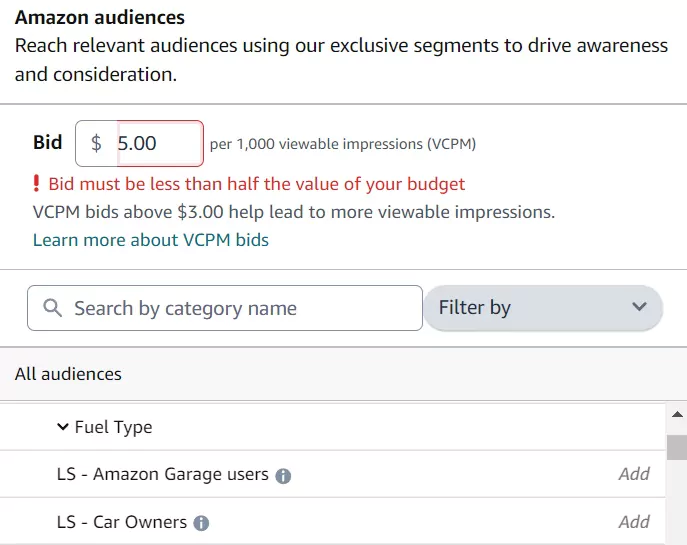

Last updated on

Alternative sellers outside of Amazon can capitalize on this profitable advertising avenue, particularly for reaching elusive customer demographics. Below are strategies for optimizing your Amazon ads.
Amazon, long hailed as the epitome of online commerce, is now extending its reach to lead generation industries.
It presents an opportunity to harness unparalleled audience segmentation capabilities.
Currently, the platform exclusively offers display advertising campaigns. Despite this restriction, it offers significant potential for businesses to connect with potential clientele.
In this piece, our objective is to delve into the process of launching ads on Amazon, their uniqueness in today’s privacy-focused digital landscape, and their impact on advertising strategies across various platforms.
It’s important to note that Amazon’s non-traditional advertising channel is still in its experimental phase. We intend to keep this article current as new features and insights emerge.
Amazon’s non-endemic advertising provides an avenue for businesses not directly involved in Amazon sales, like lead generation advertisers, to reach Amazon’s extensive user base. Presently, the advertising channel accommodates the following sectors:
Advertisers determine bid levels at the audience level and integrate them with creative assets at the campaign level, ensuring bids remain within half of their daily budget.
Targeted audiences operate on an “or” basis, facilitating broader outreach.

When aiming to target Amazon’s audience as a non-Amazon seller, let’s consider selecting options like “Users using Amazon Garage” and “Mazda car enthusiasts.”
Each audience you select requires a separate bid, and your campaign has the flexibility to target either group independently – not solely users who fall into both categories.
It’s advisable to consolidate multiple audiences into a single ad group only if you’re comfortable with all of them viewing the same ad. Alternatively, splitting them into distinct ad groups might yield better results.
Additionally, Amazon offers a market share preview of your chosen audience, presenting an overall figure rather than a forecast based on your budget allocation.
This metric proves particularly valuable as it provides a clearer understanding of the potential market reach attainable.

These advertisements not only appear on Amazon but also across its third-party network, spanning platforms such as Twitch and IMDB.
Advertisers have the option to select between two payment models: cost per click (CPC) or cost per thousand impressions (vCPM).
In our experience, CPC is ideal for those seeking tangible engagement, whereas vCPM may be more suitable for those prioritizing brand visibility.
At present, location targeting on Amazon is somewhat restricted, but advertisers can still target individuals, cities, states, or entire countries. However, this service is currently exclusive to the US market.
Undergoing and completing Amazon’s mandatory verification process is crucial to safeguard both advertisers and consumers.
For brands accustomed to focusing on Google or paid social lead generation, Amazon’s approach may appear unconventional.
At the heart of Amazon’s advertising prowess lies its audience. In an age where privacy holds utmost importance, Amazon has innovated to maintain robust yet privacy-compliant audience targeting.
Amazon’s platform offers comprehensive insights into audience behaviors without directly targeting individual users. Instead, it emphasizes detailed group characteristics.
These characteristics may stem from product views, interactions with Amazon technologies or subsidiaries (such as Whole Foods), and purchasing trends.
Google Ads and Meta Ads may misclassify certain sectors, potentially making Amazon a more favorable platform for brands.
For instance, advertisers referencing “no credit required” may occasionally be inaccurately categorized as financial services, posing challenges in the automotive sector.
Similarly, local services such as legal or wellness services, which straddle multiple categories, might find Amazon’s product-focused approach more effective for targeting relevant audiences compared to the idea-centric targeting on Google or Meta.
When planning your advertising strategy, it’s essential to view Amazon ads as a component of an incremental approach.
If you’re earmarking a portion of your budget for experimental campaigns, delving into Amazon’s advertising platform is worthwhile, particularly if you aim to strike a balance between spending on visual content campaigns and targeting more strategically.
The initial and pivotal phase in initiating an Amazon campaign involves successfully navigating through the verification process.
Once this hurdle is overcome, the subsequent steps become notably simpler. It’s imperative to register using the official legal name of your company.
If you’re establishing an account on behalf of a client, it’s crucial to ensure prompt submission of payment information. Without this vital detail, the campaign cannot commence.
The core of campaign preparation revolves around pinpointing your target audience and crafting your advertisements. You have the option to utilize Shutterstock images or incorporate your own visuals to enhance the creative aspect.
It’s important to bear in mind the platform’s restricted editing features. When creating your ads, you’ll need to craft concise text akin to a Google Display headline, limited to 90 characters.
Following the preparation of your creative components, you have the option to manually select your target audiences or utilize search-based criteria. However, it’s essential to note that if your bid exceeds 50% of your daily budget, you won’t be able to add audiences to your campaign or receive audience size estimates.
Campaigns can be customized to focus on lead generation (currently the sole available conversion event), views, or clicks. Your choice will impact whether you opt for CPC or vCPM bidding strategies.
Amazon boasts one of the most extensive audience reservoirs in existence.
Despite campaigns being currently confined to display formats, they present substantial prospects for accessing precise, occasionally elusive audience segments.
The automotive industry stands out as particularly promising, especially with the integration of Amazon Garage. Additionally, local service providers can capitalize on Amazon’s insights into consumer purchasing behaviors.
With highly competitive auction prices and precise targeting capabilities, integrating Amazon non-endemic display into testing budgets is a straightforward decision.
Original news from SearchEngineJournal